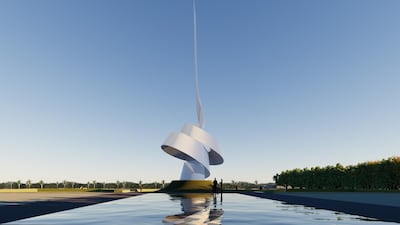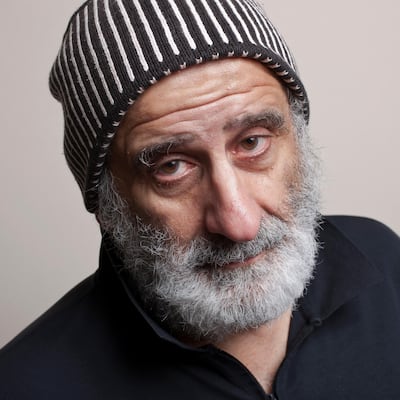A few months ago, the rulers of Sharjah were looking to commission a large public artwork to mark the start of the emirate's year as Unesco World Book Capital. A brief was drawn up and a number of international artists were approached. It wasn't a long process, though. The moment British sculptor Gerry Judah submitted his proposal, the decision was made. "I gather the Ruler of Sharjah [Sheikh Dr Sultan bin Muhammad Al Qasimi] said, 'This works, let's do it,'" Judah tells The National.
It is easy to understand why. The Scroll, which is located off Sharjah International Airport Road in front of the House of Wisdom, a library and cultural centre scheduled to open next year, is a strikingly beautiful work. Inspired by Arabic paper scrolls, Judah's towering steel sculpture unfurls in a series of diminishing white loops, some of which are only six inches apart, reaching towards the sky. "The origin of the book is the scroll, it's where it all started," Judah says. "I thought the design also nodded to Arabian calligraphy."
He says he hopes it will remind people of “the long-lasting power and significance of books and reading, to culture and heritage”.
The Scroll is about 36 metres tall and weighs 72 tonnes, but there is a gracefulness, an airy looseness, about it, as if Judah has painted a swirl in a single brushstroke straight on to a bright blue canvas. This simplicity is The Scroll's great strength. Your eye is taken from base to peak in one smooth journey round each soft curve. It demands your attention without ever feeling obtrusive. Like all great public artworks, The Scroll belongs in its surroundings; it is as if it has always been there.
"It takes work to make something simple, that is the irony of what we do," Judah says. "It is about creating that singular mark. It's quite easy to make something big and monstrous, that's never a problem. Making something with a lightness of touch and a lightness of feel is harder."
The sculpture, which took four months to design and build, is structurally complex. To make it, Judah and his team of engineers used a construction technique known as a "monocoque". This means there are no internal pipes or steelwork supporting it. "If you can make something without props, which looks as if it shouldn't be able to stand up, it is even more impressive," Judah says. "Only five per cent of the structure is steel, the other 95 per cent is air. Inside, there is nothing else, other than the rolled steel plates."
The design allows people to walk around and underneath The Scroll, looking up through the gaps in the steel folds to the sky and down at the shifting puddles of light on the ground. Judah's decision to use white steel also ensures the sculpture reacts particularly vividly to light. "It relates to the sunlight," he says. "Once you put colour on a sculpture, you're making it say something. You're creating a different sort of emotion."
Judah is best known for his large-scale installations, including several vertiginous pieces with great swooping lines that he designed for the Goodwood Festival of Speed in Britain. He relishes working on this scale, witnessing the transformation of a sketch conceived on a scrap of paper to something altogether more remarkable. "When you see it up there, the relationship between you and the scale of the piece is important," he says. "I find it impressive. There is a connection between you, the piece, the sky and the landscape."
Born in Kolkata in 1951, Judah moved to London with his family at the age of 10. After studying at Goldsmiths, University of London, and the Slade School of Fine Art, he began building sets and props for some of Britain's leading cultural institutions, including the Royal Opera House and the British Museum.
It has certainly stood him in good stead as a professional artist. Judah's work has been exhibited across Britain, including at the Imperial War Museum, where he was commissioned to create a large-scale model of part of Auschwitz-Birkenau for their Holocaust exhibition in 2000. At St Paul's Cathedral, he also built two six-metre crucifixes, each embellished with models of war-torn cities, as First World War memorials. "They pose questions about what has continued to go wrong after that war," said Judah in 2014, when the sculptures were unveiled.
The Scroll is Judah's first sculpture in the UAE and he says he hopes it will remain a prominent part of Sharjah's rich cultural landscape. "I like what Sharjah is doing," he says. "It's trying hard to hold on to its cultural aspirations, rather than simply being a tourist destination. Everybody goes to Dubai for a luxury holiday but Sharjah is different altogether."



